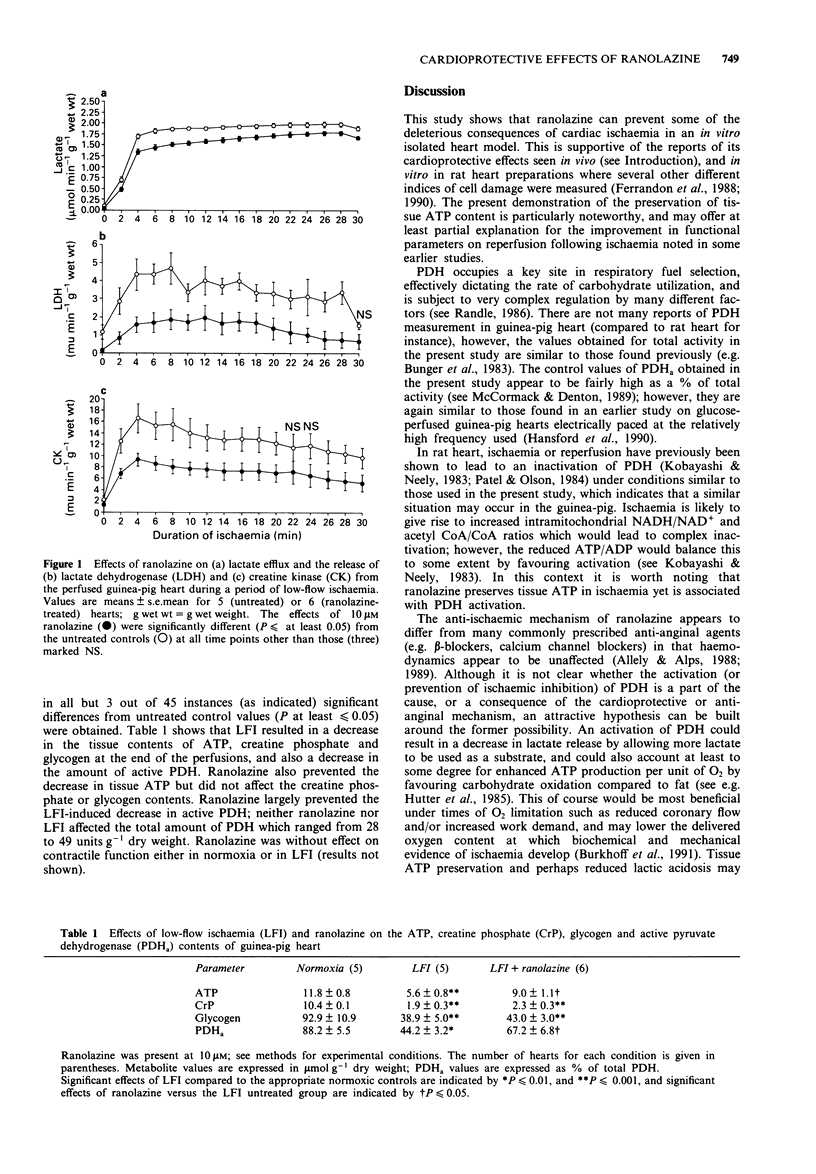Abstract
1. In isolated Langendorff-perfused, electrically-paced, hearts of guinea-pigs, global low-flow-ischaemia (LFI; at 0.7 ml min-1) resulted in marked increases in the rates of release of lactate, lactate dehydrogenase (LDH) and creatine kinase (CK) over a 30 min period. At the end of the LFI period, tissue ATP content was significantly reduced from a control value of 11.8 +/- 0.8 (5) to 5.6 +/- 0.8 (5) mumol g-1 dry weight. 2. The presence of ranolazine [(+/-)-N-(2,6-dimethyl-phenyl)-4[2-hydroxy-3-(2-methoxy-phenoxyl)- propyl] - l-piperazine acetamide dihydro-chloride; RS-43285-193] at 10 microM, from 20 min prior to and during LFI, resulted in significant reductions in the release of lactate, LDH and CK during the ischaemic period and a significant preservation of tissue ATP (9.0 +/- 1.1 (6) mumol g-1 dry wt.). Ranolazine did not prevent the reductions in creatine phosphate or glycogen observed in LFI, nor did it have any significant effects on any contractile parameters before or during the LFI period. 3. Neither ranolazine nor LFI affected the total amounts of tissue pyruvate dehydrogenase (PDH) activity; however, the significant reduction in the amount of active, non-phosphorylated PDH caused by LFI (from 88.2 +/- 5.5 to 44.2 +/- 3.2% of total activity) was partially but significantly prevented by ranolazine (67.2 +/- 6.8%). This effect of ranolazine on PDH may be part of the mechanism whereby the compound reduces lactate release and preserves tissue ATP during ischaemia.
Full text
PDF


Selected References
These references are in PubMed. This may not be the complete list of references from this article.
- Allely M. C., Alps B. J. A comparison of the effects of a series of anti-anginal agents in a novel canine model of transient myocardial ischaemia. Br J Pharmacol. 1989 Apr;96(4):977–985. doi: 10.1111/j.1476-5381.1989.tb11910.x. [DOI] [PMC free article] [PubMed] [Google Scholar]
- Allely M. C., Alps B. J. Prevention of myocardial enzyme release by ranolazine in a primate model of ischaemia with reperfusion. Br J Pharmacol. 1990 Jan;99(1):5–6. doi: 10.1111/j.1476-5381.1990.tb14641.x. [DOI] [PMC free article] [PubMed] [Google Scholar]
- Burkhoff D., Weiss R. G., Schulman S. P., Kalil-Filho R., Wannenburg T., Gerstenblith G. Influence of metabolic substrate on rat heart function and metabolism at different coronary flows. Am J Physiol. 1991 Sep;261(3 Pt 2):H741–H750. doi: 10.1152/ajpheart.1991.261.3.H741. [DOI] [PubMed] [Google Scholar]
- Bünger R., Permanetter B., Yaffe S. Energy utilization and pyruvate as determinants of pyruvate dehydrogenase in norepinephrine-stimulated heart. Pflugers Arch. 1983 May;397(3):214–219. doi: 10.1007/BF00584360. [DOI] [PubMed] [Google Scholar]
- Cocco G., Rousseau M. F., Bouvy T., Cheron P., Williams G., Detry J. M., Pouleur H. Effects of a new metabolic modulator, ranolazine, on exercise tolerance in angina pectoris patients treated with beta-blocker or diltiazem. J Cardiovasc Pharmacol. 1992 Jul;20(1):131–138. [PubMed] [Google Scholar]
- De Sarro G. B., Meldrum B. S., Nisticó G. Anticonvulsant effects of some calcium entry blockers in DBA/2 mice. Br J Pharmacol. 1988 Feb;93(2):247–256. doi: 10.1111/j.1476-5381.1988.tb11428.x. [DOI] [PMC free article] [PubMed] [Google Scholar]
- Hansford R. G., Hogue B., Prokopczuk A., Wasilewska E., Lewartowski B. Activation of pyruvate dehydrogenase by electrical stimulation, and low-Na+ perfusion of guinea-pig heart. Biochim Biophys Acta. 1990 Jul 25;1018(2-3):282–286. doi: 10.1016/0005-2728(90)90268-9. [DOI] [PubMed] [Google Scholar]
- Hütter J. F., Piper H. M., Spieckerman P. G. Effect of fatty acid oxidation on efficiency of energy production in rat heart. Am J Physiol. 1985 Oct;249(4 Pt 2):H723–H728. doi: 10.1152/ajpheart.1985.249.4.H723. [DOI] [PubMed] [Google Scholar]
- Jain D., Dasgupta P., Hughes L. O., Lahiri A., Raftery E. B. Ranolazine (RS-43285): a preliminary study of a new anti-anginal agent with selective effect on ischaemic myocardium. Eur J Clin Pharmacol. 1990;38(2):111–114. doi: 10.1007/BF00265967. [DOI] [PubMed] [Google Scholar]
- Kobayashi K., Neely J. R. Effects of ischemia and reperfusion on pyruvate dehydrogenase activity in isolated rat hearts. J Mol Cell Cardiol. 1983 Jun;15(6):359–367. doi: 10.1016/0022-2828(83)90320-6. [DOI] [PubMed] [Google Scholar]
- McCormack J. G., Denton R. M. Influence of calcium ions on mammalian intramitochondrial dehydrogenases. Methods Enzymol. 1989;174:95–118. doi: 10.1016/0076-6879(89)74013-1. [DOI] [PubMed] [Google Scholar]
- Patel T. B., Olson M. S. Regulation of pyruvate dehydrogenase complex in ischemic rat heart. Am J Physiol. 1984 Jun;246(6 Pt 2):H858–H864. doi: 10.1152/ajpheart.1984.246.6.H858. [DOI] [PubMed] [Google Scholar]
- Randle P. J. Fuel selection in animals. Biochem Soc Trans. 1986 Oct;14(5):799–806. doi: 10.1042/bst0140799. [DOI] [PubMed] [Google Scholar]


